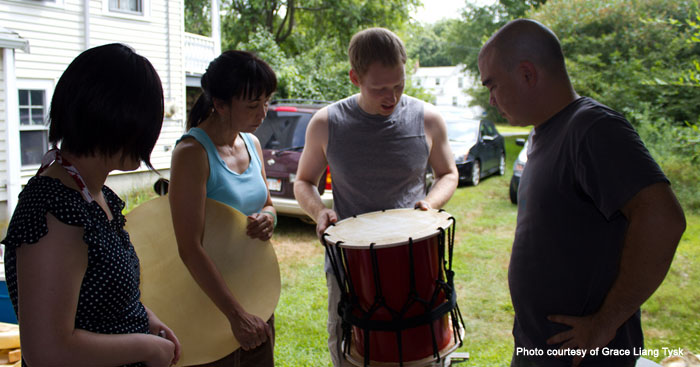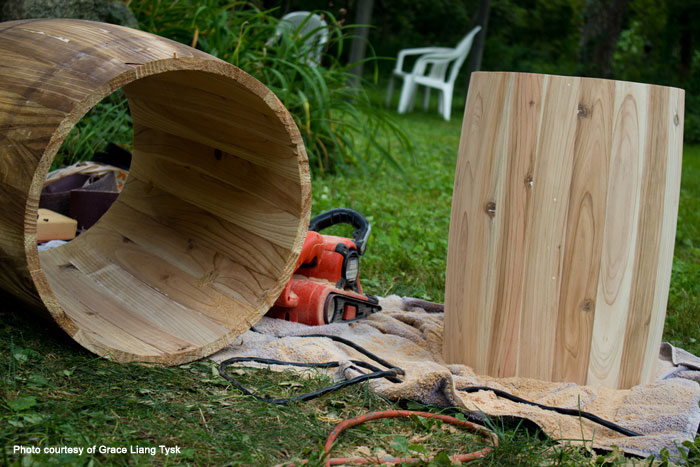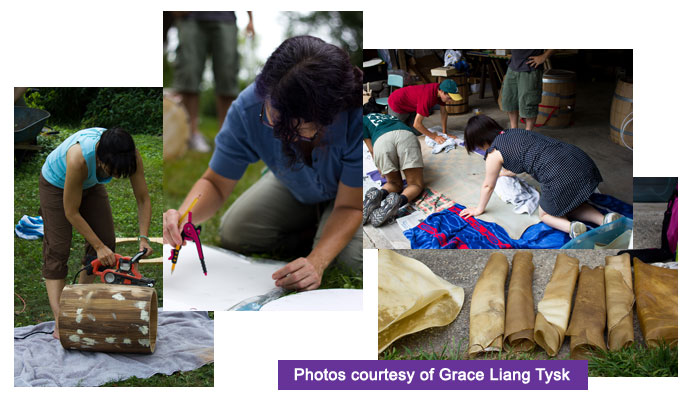Whether perceived or real, pretty much every taiko group has an equipment shortage. (Who doesn’t want more dums?) Taiko are expensive. Maybe you need more chus, odaiko, or shime. Groups tend to supplement their stock of drums by building practice drums out of PVC, cardboard, tires, tape, trash cans, etc… However, playing drums with heads made out of packing tape isn’t exactly the performance paradigm that we all strive for, so if you are short on a particular type of drum you need to think about making some of your own. Taiko building skills, however, aren’t exactly something everybody is born with. You are luck if you have a few people in your group that are up to the task. Those few try to include other people in the process, which is great, but watching someone build a drum or hammering in a few tacks is different from actually doing it from start to finish. Also, by extension, teaching someone how to build a drum presents its own set of challenges. The experience of building a drum from start to finish is in some ways a right of passage that I think everybody should experience. Once you have done it yourself you have not only a greater understanding and connection with your drums but a greater understand of all the work those people in your group who make the drums (and stands!) go through to provide you with that equipment.
Mark H Rooney started a building project at ONE a while back to have all the members build themselves okedo. Currently we have about 15 people attempting to make over 20 okedo (some of us are making two). The interesting part about this is that everybody, regardless of drum-building skill or experience, is attempting to do the same thing independently. Initial progress was slow, finding all the materials required at a reasonable price was challenging. Eventually we identified a source for barrels that could be converted into appropriate bodies. (Making stave bodies is too advanced for someone with no woodworking experience.) Rings were more difficult and took quite a bit of searching before finding someone who could make enough of the right size for a reasonable price. Skins were easy, we buy those all the time. The total materials cost per drum is about $150 depending on the size (we are making a few different sizes). Now comes the hard part, actually building the drums.
Mark H was the first to finish an okedo, being an experienced builder with 60+ drums under his belt (yes, he has a very large belt). This was his first okedo though, and he was kind enough to make a lot of the mistakes for us. Let me tell you, that advice and foreknowledge is invaluable and we appreciate is immensely! I recently finished mine as well (at least my first, I still have to tackle the second). Mark and I compared notes and even though we used the same set of resources (primarily Brian’s excellent guide to Making an Okedo-Daiko) we ended up with two very different drums built with some pretty divergent methods. We compared notes and shared our experience with the group and anybody else who would listen. Based on what we learned from each other we are each going to go about building our second drums differently. Many of the other members have made progress on or finished their bodies at this point and are moving on to sewing their heads. Many of these people who cut, shaped, sanded, and painted those barrels into bodies don’t even own a saw and have no woodworking experience at all, yet they are getting it done and doing a great job. So far all the bodies are very unique, each one is a snowflake that reflects the builders personality. Since we are only providing each other advice and leaving each individual to do ALL the work on their own we are seeing a lot of interesting and unique ideas develop. I’m excited to see how they will all turn out!






